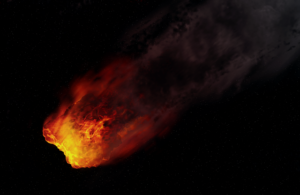
You may not be aware of 99942 Apophis, but you’ll undoubtedly hear a lot about it over the next few years.
Because the asteroid will pass near Earth on April 2029 by the narrowest of razor-thin margins, you can anticipate hearing it referred to quite frequently in the months ahead as April 2029 approaches.
According to scientists, 99942 Apophis may come close enough to Earth during its flyby on April 2029 to cause various types of damage, up to and including a complete annihilation of the human race.
In 2004, NASA scientists estimated that the asteroid had a good possibility of colliding with the Earth.
Since then, observations and calculations have shown that it is unlikely. However, if events had played out differently in the dance between the Earth, Apophis, and the sun, the space rock might well have landed on our planet.
But you’re right, we will continue to dance for a long time, and the day may come when Apophis and Earth do shake hands, and it won’t be pleasant.
What is asteroid Apophis?
Asteroid Apophis is a near-Earth asteroid, discovered on June 19th, 2004 by the LINEAR project. Its diameter roughly measures 270 m, making it larger than the Eiffel Tower or London’s Big Ben.
In 2029, it will fly past Earth at a minimum distance of more than 37 000 km – 19.7 times the radius of our planet!
Its next close approach to Earth is on April 13th, 2029, coming no closer than about 30 million miles (0.093 astronomical unit), or about 36 000 km from the surface of our planet.
Way off in space, there are three asteroids with orbits that are about the same size as Earth’s, one of which is Apophis now.
Three billion years ago, there were probably many more, but most got thrown into smaller pieces by collisions or got pulled into Mars or Venus (or out of our Solar System altogether).
Asteroids aren’t like the Moon – they don’t have enough gravity to pull themselves together.
They’re more like broken-up bits of Earth or Mars – they weren’t big enough when they were formed to be able to pull themselves together, so what you’ve got is a whole lot of smaller bits of rock and metal going around the Sun in the same orbit.
How big is the size of Apophis

When an asteroid impacts the Earth, a number of factors influence how much damage, if any, it causes. These variables include but are not limited to, the object’s dimensions, weight, and angle of entry into the atmosphere.
The size and weight of Apophis are unquestionably known.
The thing is said to be about 885 feet in diameter (a hair smaller than the Eiffel Tower) and 2.1 x 10 to the tenth kg in mass, according to Universe Today.
If those figures are meaningless to you, consider this: Arizona’s Meteor Crater, which is about one mile across, was created by an object less than 150 feet in diameter.
Apophis will take 32 minutes to pass over New Zealand and 2:28 hours to go from South America to Antarctica, according to Astronomy Magazine.
As HuffPost’s astronomy blogger Nick Howes put it, “that’s a long time for a movie but a very quick time for a 400 meter asteroid to cross the Earth’s diameter.”
According to NASA, the asteroid Apophis will pass roughly 745 miles from Earth on April 13, 2029. It has a diameter of about 1,000 feet and is estimated to be composed of an iron and nickel-rich composition.
If it were to strike Earth, it would likely deliver us an energy equivalent of 880 megatons
How fast the speed of Apophis
Apophis’ velocity relative to Earth is about 20 km/s, which is 44 000 miles per hour.
To put that in perspective, Apollo astronauts traveling to and from the Moon did so at a relatively slow speed of about 6.3 km/s (1500 MPs) relative to Earth.
Comparison of an impact by asteroid Apophis with other natural catastrophes
An object of this size has the potential to cause continent-wide damage, but thankfully an impact is highly improbable especially in 2036 when it is expected to pass closer than the orbit of some satellites.
An unlikely collision in 2029 could break the asteroid into pieces that will pass by Earth in 2036 and 2068.
The reason the 2029 asteroid is so important is that it offers astronomers an unprecedented chance to observe this slice of space rock up-close as it zooms past our planet.
After studying Apophis up close, scientists would likely be able to figure out exactly where it came from and how an asteroid of its size could impact Earth hundreds of years in the future.
What happens if Apophis hit a populated area
Now that we’ve seen what damage Apophis can do, it’s time to look at some real-world examples of what would happen if it strikes.
And it should go without saying that the place where it hits will have an impact on how much devastation it causes.
According to Universe Today, if the asteroid impacts (assuming it hits land), a one-mile wide crater will be created with a 10 mile deep dent.
A ten-mile diameter will experience a 60-mile high tsunami that could severely damage the US East Coast and inflict minor to moderate damage on most of the United States, including Washington D.C., as well as parts of Europe and Africa.
Consider what happened to Hiroshima and Nagasaki if you don’t believe any of it is over the top. A nuclear bomb delivering a fraction of the energy that Apophis would release exploded over the cities, killing about 200,000 people (according to Newsweek).
Apophis’s effect would be far greater than either of the Hiroshima or Nagasaki weapons.
The impact of such a large object would send dust and debris high into the atmosphere, blocking out much of the light from the Sun.
This could starve plants and animals that rely on photosynthesis for food, which would cause widespread extinction in just a few years.
However, because Apophis is still in the distance and we know so little about the asteroid, no one can say for certain what its effect will be on Earth.
Fortunately, its chances of striking a populated area are slim. In fact, considering that almost 75% of the Earth’s surface is covered by water, the chances of it striking land are extremely small.
Statistically speaking, Apophis is most likely to land in the ocean because of this statistic.
What happens if Apophis land in the ocean

You’ve undoubtedly seen little ripples spreading out in all directions if you’ve ever hurled a stone into a placid lake. Water displacement and subsequent wave patterns are all real-world examples of physics concepts that you can observe every day.
Imagine a massive rock (Apophis) slamming into a huge lake (the ocean). It, too, will cause rippling waves that will spread out in all directions, according to Universe Today.
And those ripples will grow into devastating tsunamis that may reach across several continents. Given that so many people dwell on the coast, the loss of life caused by Apophis-generated tsunamis could be staggering.
For example, scientist Neil deGrasse Tyson stated that a tsunami or several tsunamis caused by Apophis’ impact in the Pacific Ocean could decimate the West Coast of North America.
“So what happens is, all of this man-made stuff, all of these houses and factories, are churned into the ablative force that sand and rock and water makes. So you’ll have a half-mile of just sandbars of material that used to be your city.”
And tsunamis don’t stop once they hit land, either. After they cross the coastline, they will continue inland as rivers, lakes and ponds are inundated by massive walls of water.
There will most likely be no global catastrophes
Another consequence of an asteroid striking the Earth is that it causes long-term damage that is not easily visible.
Asteroid impacts have kicked up so much dust and debris into the atmosphere in some instances that they have caused climate change.
The so-called K-T impact, according to Planetary Science Institute, was responsible for such severe climate change that it caused many species of life on Earth to become extinct.
However, consider what happened to the dinosaurs.
While it probably did not completely wipe out all life on Earth, it certainly caused a mass extinction that led to the evolution of other forms of life more conducive to survival in the changing environment.
This is most likely how things will play out if Apophis strikes us.
That asteroid, on the other hand, was far bigger than even Apophis.
According to Universe Today, you shouldn’t anticipate this particular space rock to generate enough debris to cause long-term climate change.
However, according to Express, a PHA impact could potentially result in significant climate change. Clearly, the experts have different viewpoints on this scenario.
Keep in mind that Apophis is only a minimum of 150 meters wide.
This means that if it landed on land, it would definitely cause regional damage and possibly even result in some degree of long-term climate change if enough debris was kicked up into the atmosphere.
It’s also worth noting, however, that not all naturally occurring phenomena-induced climate changes are catastrophic or long-term.
Volcanoes erupt constantly, causing brief disruptions in climate, as NASA points out. Perhaps Apophis might induce a similar short-term period of climate change.
- See also: what would happen if the earth stops spinning
- See also: what would happen if the speed of light was significantly slower
There’s nothing we can do about Apophis.
We may know (or think) that we’re almost certainly safe from Apophis when it passes by in 2029 thanks to observations and calculations.
However, there are thousands of these objects floating around in space. However, it turns out that there isn’t a whole lot we can do about them.
Furthermore, any asteroid mitigation strategies at this time are years or even decades away, according to NASA.
This doesn’t stop scientists from trying to find ways to protect the Earth from PHA impacts, though.
They are developing several options, including improved asteroid characterization and deflection methods – all of which require a substantial amount of time and money before they can be put into action.
Of course, we might not ever need these methods if Apophis is the only PHA asteroid to slam into us. As most observations and calculations show, it probably won’t.
According to Space.com, researchers are considering a number of methods for potentially interfering with an asteroid’s approach to Earth.
One option is to build a barrier between the rock and the planet in the hopes of slowing down the invader just enough that the planet survives in danger.
However, doing so would necessitate several precise space missions over a few months.
Unfortunately, all of this is mostly theory, and no real asteroid avoidance technology exists or is near to being developed. And when an Apophis-sized (or larger) space rock strikes our planet’s neighborhood, that has already happened.



